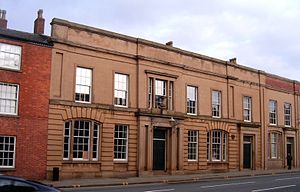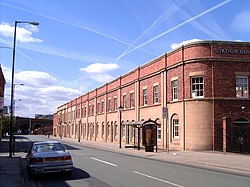
The Liverpool and Manchester Railway (L&MR) was the first inter-city railway in the world. It opened on 15 September 1830 between the Lancashire towns of Liverpool and Manchester in England. It was also the first railway to rely exclusively on locomotives driven by steam power, with no horse-drawn traffic permitted at any time; the first to be entirely double track throughout its length; the first to have a true signalling system; the first to be fully timetabled; and the first to carry mail.

Manchester Piccadilly is the main railway station of the city of Manchester, in the metropolitan county of Greater Manchester, England. Opened originally as Store Street in 1842, it was renamed Manchester London Road in 1847 and became Manchester Piccadilly in 1960. Located to the south-east of the city centre, it hosts long-distance intercity and cross-country services to national destinations including London, Birmingham, Nottingham, Glasgow, Edinburgh, Cardiff, Bristol, Exeter, Plymouth, Reading, Southampton and Bournemouth; regional services to destinations in Northern England including Liverpool, Leeds, Sheffield, Newcastle and York; and local commuter services around Greater Manchester. It is one of 19 major stations managed by Network Rail. The station has 14 platforms: 12 terminal and two through platforms. Piccadilly is also a major interchange with the Metrolink light rail system with two tram platforms in its undercroft.
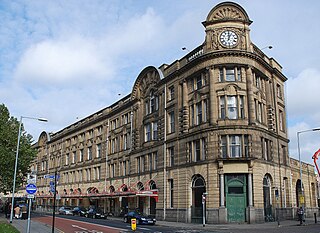
Manchester Victoria station in Manchester, England, is a combined mainline railway station and Metrolink tram stop. Situated to the north of the city centre on Hunts Bank, close to Manchester Cathedral, it adjoins Manchester Arena which was constructed on part of the former station site in the 1990s. Opened in 1844 and part of the Manchester station group, Manchester Victoria is Manchester's second busiest railway station after Piccadilly, and is the busiest station managed by Northern.

Castlefield is an inner-city conservation area in Manchester, North West England. The conservation area which bears its name is bounded by the River Irwell, Quay Street, Deansgate and Chester Road. It was the site of the Roman era fort of Mamucium or Mancunium which gave its name to Manchester. It was the terminus of the Bridgewater Canal, the world's first industrial canal, built in 1764; the oldest canal warehouse opened in 1779. The world's first passenger railway terminated here in 1830, at Liverpool Road railway station and the first railway warehouse opened here in 1831.

Manchester Oxford Road railway station is a railway station in Manchester, England, at the junction of Whitworth Street West and Oxford Street. It opened in 1849 and was rebuilt in 1960. It is the third busiest of the four stations in Manchester city centre.

Earlestown railway station is a railway station in Earlestown, Merseyside, England, and one of the few "triangular" stations in Britain.

Edge Hill railway station is a railway station that serves the district of Edge Hill, Liverpool, England and is one of the oldest railway stations in the world.

Deansgate is a railway station in Manchester city centre, England, 1,100 yards (1 km) west of Manchester Piccadilly, close to Castlefield at the junction of Deansgate and Whitworth Street West. It is part of the Manchester station group.

Warrington Central is one of three main railway stations serving the town of Warrington in Cheshire, England. It is located on the southern route of the Liverpool to Manchester Lines, the former Cheshire Lines Committee route between Liverpool and Manchester; the station is situated approximately halfway between the two cities.
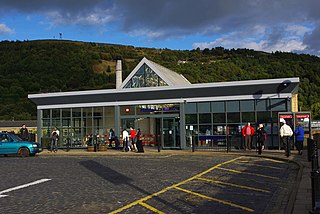
Halifax railway station serves the town of Halifax in West Yorkshire, England. It lies on the Calder Valley line and is 17 miles (27 km) west from Leeds.

Manchester Exchange was a railway station in Salford, England, immediately north of Manchester city centre, which served the city between 1884 and 1969. The main approach road ran from the end of Deansgate, near Manchester Cathedral, passing over the River Irwell, the Manchester-Salford boundary and Chapel Street; a second approach road led up from Blackfriars Road. Most of the station was in Salford, with only the 1929 extension to platform 3 east of the Irwell in Manchester.

Rainhill railway station serves the district of Rainhill in Merseyside, England. It is situated on the electrified northern route of the Liverpool to Manchester Line, forming part of the Liverpool City Line. The station, and all trains serving it, are operated by Northern Trains on behalf of Merseytravel and are branded as Merseytravel services.

The Manchester South Junction and Altrincham Railway (MSJ&AR) was a suburban railway which operated an 8+1⁄2-mile (14 km) route between Altrincham in Cheshire and Manchester London Road railway station in Manchester.
Manchester Oldham Road station opened in 1839 as the terminus station of the Manchester and Leeds Railway (M&LR) in Collyhurst, Manchester. When the M&LR opened Manchester Victoria in 1844 as its new Manchester passenger station Oldham Road was converted to a goods station which it remained until its closure in 1968.
Leigh was a railway station in Bedford, Leigh, Greater Manchester, England, United Kingdom, on the London and North Western Railway. Leigh was in the historic county of Lancashire. Its station opened as Bedford Leigh in 1864, was renamed Leigh & Bedford in 1876 and Leigh in 1914. The station closed in 1969.

Ordsall Chord, also known as the Castlefield Curve, is a short railway line in Ordsall, Salford, England, which links Manchester Piccadilly and Manchester Oxford Road to Manchester Victoria, designed to increase capacity and reduce journey times into and through Manchester. It allows trains to run from Leeds, Newcastle and Redcar Central direct to Manchester Airport.

The River Irwell Railway Bridge was built for the Liverpool & Manchester Railway (L&MR), the world's first passenger railway which used only steam locomotives and operated as a scheduled service, near Water Street in Manchester, England. The stone railway bridge, built in 1830 by George Stephenson, was part of Liverpool Road railway station. The bridge was designated a Grade I listed building on 19 June 1988.

The Northern Hub was a rail upgrade programme between 2009 and 2020 in Northern England to improve and increase train services and reduce journey times between its major cities and towns, by electrifying lines and removing a major rail bottleneck in Manchester. It was predicted to stimulate economic growth in the region. The project had several elements but the prime objective was to eradicate the bottleneck in Manchester and allow trains to travel through the city at speed without stopping. The project was announced as the Manchester Hub in 2009. The project's steering partnership involved Network Rail, Deutsche Bahn, First TransPennine Express, Northern Rail, East Midlands Trains, CrossCountry, Freightliner, the Department for Transport, Transport for Greater Manchester and Merseytravel.
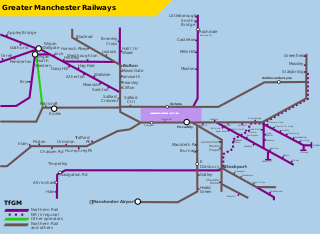
The Manchester station group is a station group of four railway stations in Manchester city centre, England; this consists of Manchester Piccadilly, Manchester Oxford Road, Manchester Victoria and Deansgate. The station group is printed on national railway tickets as MANCHESTER STNS. For passengers travelling from one of the 91 National Rail stations in Greater Manchester, the four stations are printed as MANCHESTER CTLZ which additionally permits the use of Metrolink tram services in Zone 1.

The Castlefield corridor is a railway corridor between Castlefield junction and Fairfield Street junction in Greater Manchester, England. The corridor forms the eastern end of the southerly Liverpool–Manchester line.
